
Maryborough Courthouse is a heritage-listed courthouse at 170 Richmond Street, Maryborough, Fraser Coast Region, Queensland, Australia. It was designed by Francis Drummond Greville Stanley and built in 1877 by John Thomas Annear for the Queensland Government. It is also known as Maryborough Court House and Government Offices. It was added to the Queensland Heritage Register on 21 October 1992.
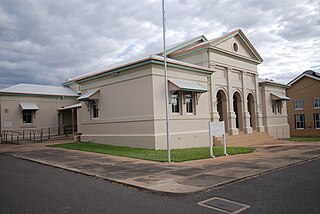
Charters Towers Courthouse is a heritage-listed courthouse at 28 Hodgkinson Street, Charters Towers City, Charters Towers, Charters Towers Region, Queensland, Australia. It was designed by John James Clark and built in 1886 by Charles Miller. It is also known as Charters Towers Courthouse. It was added to the Queensland Heritage Register on 21 October 1992.
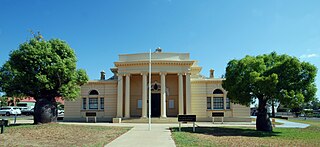
Roma Courthouse is a heritage-listed courthouse at 141 McDowall Street, Roma, Maranoa Region, Queensland, Australia. Constructed in 1901, the courthouse is a rendered masonry building, which is still in use today. Predominately influenced by the Federation free style, it is considered a stunning example of Federation colonial architecture at its best. It is also known as Roma Court House and Roma Police Buildings. It was added to the Queensland Heritage Register on 7 August 1998.

Toowoomba Police Station Complex is a heritage-listed police station at 50–52 Neil Street, Toowoomba, Queensland, Australia. It was designed by Raymond Clare Nowland and built in 1935. It was added to the Queensland Heritage Register on 5 October 1998.

Woolloongabba Police Station is a heritage-listed former police station at 842–848 Main Street, Woolloongabba, City of Brisbane, Queensland, Australia. It was designed by the Queensland Department of Public Works and built from 1913 to 1936. It is also known as South Coast District Headquarters and Woolloongabba Police Station. It was added to the Queensland Heritage Register on 25 November 1994.

Petrie Terrace Police Depot is a heritage-listed former police barracks at 25–61 Petrie Terrace, Petrie Terrace, City of Brisbane, Queensland, Australia. It was built from 1850s to 1960s. It was added to the Queensland Heritage Register on 23 July 1999.

Kyeewa is a heritage-listed villa at 1 York Street, East Ipswich, City of Ipswich, Queensland, Australia. It was built c. 1890 for Ernest Greenway. It was added to the Queensland Heritage Register on 21 October 1992.

Rosewood Courthouse is a heritage-listed courthouse at 1 John Street, Rosewood, City of Ipswich, Queensland, Australia. It was built from 1908 to 1923. It is also known as Rosewood police residence. It was added to the Queensland Heritage Register on 6 June 1994.
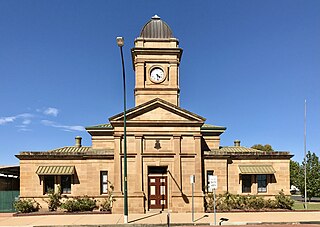
Warwick Court House and Police Complex is a heritage-listed courthouse at 88 Fitzroy Street, Warwick, Southern Downs Region, Queensland, Australia. It was designed by John James Clark and built from 1885 to 1914 by William G Conley. It was added to the Queensland Heritage Register on 21 October 1992.
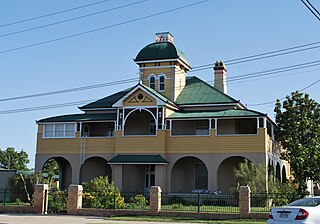
St Mary's Presbytery is a heritage-listed Roman Catholic presbytery of St Mary's Roman Catholic Church at 142 Palmerin Street, Warwick, Southern Downs Region, Queensland, Australia. It was designed by Wallace & Gibson and built from 1885 to 1887 by John McCulloch. It is also known as Father JJ Horan's private residence. It was added to the Queensland Heritage Register on 31 July 2008.

Maryborough Base Hospital is a heritage-listed hospital at Walker Street, Maryborough, Fraser Coast Region, Queensland, Australia. It was designed by Queensland Colonial Architect John James Clark and built from 1887 by Robert Taylor. It is also known as Maryborough General Hospital. It was added to the Queensland Heritage Register on 2 February 1998.

Rockhampton Courthouse is a heritage-listed courthouse at 42 East Street, Rockhampton, Rockhampton Region, Queensland, Australia. It was designed by John Hitch and built from 1950 to 1955. It is also known as District Court, Queensland Government Savings Bank, Commonwealth Bank, Magistrate's Court, Police Court, and Supreme Court. It was added to the Queensland Heritage Register on 21 October 1992.

Bundaberg Police Station is a heritage-listed former court house (1882–1958) and former police station (1958–1997) at Quay Street, Bundaberg Central, Bundaberg, Bundaberg Region, Queensland, Australia. It was built from 1882 to 1958. It is also known as Bundaberg Court House. It was added to the Queensland Heritage Register on 1 December 1998.

Commercial Bank of Sydney is a heritage-listed former bank building at 191–193 Bourbong Street, Bundaberg Central, Bundaberg, Bundaberg Region, Queensland, Australia. It was designed by George Allen Mansfield and built in 1891. It is also known as the National Australia Bank. It was added to the Queensland Heritage Register on 21 October 1992.
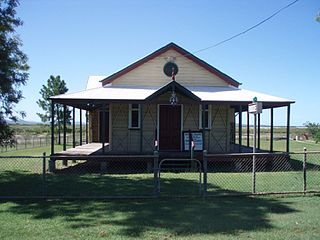
St Lawrence Police Station is a heritage-listed police station and former courthouse at Macartney Street, St Lawrence, Isaac Region, Queensland, Australia. It was built from 1878 to 1934. It is also known as former St Lawrence Courthouse and Cell Block. It was added to the Queensland Heritage Register on 24 November 2000.

Charters Towers Masonic Lodge is a heritage-listed masonic temple at 20 Ryan Street, Charters Towers City, Charters Towers, Charters Towers Region, Queensland, Australia. It was built from 1887 to 1897. It was added to the Queensland Heritage Register on 21 October 1992.

Ravenswood Court House and Police Station is a heritage-listed former courthouse and police station at Raven Street, Ravenswood, Charters Towers Region, Queensland, Australia. They were designed by the Queensland Department of Public Works and were built in 1882 by A Donald and FA Sparre. They are also known as Ravenswood Court House Group. They were added to the Queensland Heritage Register on 27 January 1994.
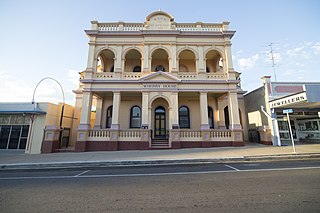
Bank of New South Wales is a heritage-listed former bank building at 34–36 Gill Street, Charters Towers City, Charters Towers, Charters Towers Region, Queensland, Australia. It was designed by Eyre & Munro and built in 1889 by Kelleher. It is also known as Wherry House. It was added to the Queensland Heritage Register on 9 November 2012.

Aldborough is a heritage-listed villa at 25 Deane Street, Charters Towers City, Charters Towers, Charters Towers Region, Queensland, Australia. It was designed by William Henry Allan Munro and built in 1900 by Thomas Barry O'Meara. It was added to the Queensland Heritage Register on 14 August 2008.

Charters Towers Post Office is a heritage-listed post office at 17 Gill Street, Charters Towers City, Charters Towers, Charters Towers Region, Queensland, Australia. It was added to the Australian Commonwealth Heritage List on 8 November 2011.






















